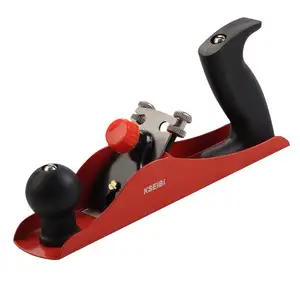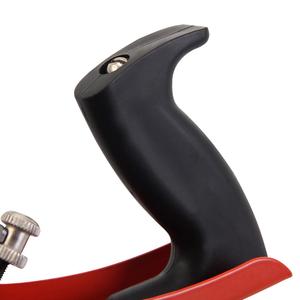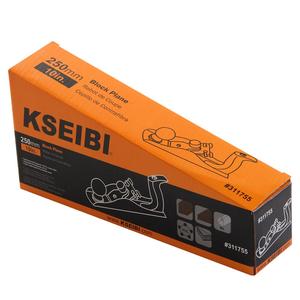
All categories
Featured selections
Trade Assurance
Buyer Central
Help Center
Get the app
Become a supplier

(961 products available)


































Jack planes are crucial for smoothing, block, and bullnose planes. All these types have distinct features and benefits. Understanding the differences will help one make informed decisions. Below are the common types of jack planes.
These planes are made of wood. Each of these planes is specifically designed for general planing tasks. They have a slightly curved blade for shape cutting along the grain of the wood, known as sconces. The wooden body ensures durability and stability during use. Wooden jack planers are famous for their smooth cuts and ergonomic design.
These planes are typically made of steel or iron. Just like wooden jack planes, metal jack planes have a simple body structure that makes them suitable for general planing tasks. These planes are famous for their durability. Also, they provide a more stable and heavier construction compared to their wooden counterparts. They are preferred by woodworkers who need consistent results and demand greater control over the tool’s movements.
They allow users to adjust the depth and angle of the blade. This feature makes them versatile. Woodworkers can easily switch between tasks such as roughing and finishing. These adjustable jacks also combine the properties of both types mentioned above. So they offer flexibility and meet a variety of planning needs. They are especially useful for professionals who require adjustments to cater to different wood types.
The corrugated jack planes have a ridged sole. This sole is designed to remove more material with each pass. These planes are ideal for large surfaces because the corrugations leave shallow grooves. These grooves are later easily sanded or planed over. Although not as common as smooth varieties, they are beneficial.
A business owner just starting out needs to consider various factors to choose jack planes in bulk. Prioritizing quality, customer needs, and market trends when selecting these factors is essential for sustained growth. Below are the factors to consider.
That’s because a novice might prefer a jack plane with an angled bed for easy usage. A classic user would normally choose a jack plane with a frog adjustment for more control. Also, the woodworker might use a smooth jack plane for basic tasks. A jack that can perform dual tasks like smoothing and flattening would be chosen if the woodworker takes various projects.
Jack planes come with different blade materials. Each material offers different levels of sharpness and durability. The most common blade material is carbon steel. This steel is easy to sharpen and maintains a sharp edge for a long time. There is also high-speed steel. This one is more durable and can withstand heat generated during extensive use.
A jack plane with a sturdy body will serve the user for many years. Also, one that requires frequent replacement will be more costly in the long run. Select models with tight tolerances between the body and the blade. This feature ensures smooth operation with minimal chatter.
This factor plays a major role in choosing hand plane tools. If the customers prefer hand-tool woodworking, select planes that require manual adjustment. These types give the user more control over the planing process. For users who incorporate powered solutions, opt for electric jack planes. These electric ones are efficient and are ideal for quickly removing large amounts of material.
There is hardwood. People usually pick it up for its density and fine grain. Then there is softwood. This type tends to be less dense and easier to work with. Each has an effect on the type of jack plane best suited for the job. For example, a wooden jack plane works best when used on hardwoods. It provides a smooth finish without causing excessive wear on the tools.
Understanding how to use these planes properly ensures efficient operation. Below are the usage scenarios of jack planes with some common maintenance tips.
Jack planes are used to create a smooth surface on the face of the workpiece. Start by adjusting the blade to a fine depth. Then, take a few passes across the wood to remove any irregularities.
Plan the edges of the wood to ensure they are straight and have the same width. Place the workpiece on the edge and lengthwise pass the plane to achieve a uniform edge. Maintain consistent pressure to prevent splintering.
These planes are very effective when creating tapered legs for furniture. The adjustment of the blade allows for finer cuts at one end of the leg than the other. This feature will create a gentle taper.
Use a jack plane to reduce the thickness of a workpiece. To achieve the desired thickness, take repeated passes while adjusting the blade depth incrementally. This practice gives more control over material removal rates.
A jack plane is mainly used to smooth the surface of wood. Begin by setting the blade to take a thin shave. Then, move the plane in the direction of the wood grain. Apply even pressure and moisture to achieve a uniform smooth finish.
The jack plane has a frog that holds the blade. Adjust the frog to change the blade's angle for varying cuts. A steeper angle gives a finer cut, while a shallow angle removes more wood. This adjustment allows for more control over the planing process.
For optimal performance, regularly sharpen the blade of the jack plane. Use a sharpening stone or jig to maintain a 25-degree bevel. This practice ensures the blade remains sharp enough to produce clean cuts.
Maintain the body of the jack plane by regularly cleaning it after each use. Remove any wood and debris. Then, apply a thin layer of wax to the sole to prevent rusting and reduce friction.
The adjusting lever on the jack plane helps set the blade depth. Loosen the lever and turn it to adjust the blade exposure. This mechanism enables the user to achieve the desired cut depth quickly.
Moisture can cause the wooden jack plane to warp over time. Maintain a wooden jack plane by keeping it in a climate-controlled environment with moderate humidity. This practice prevents the wood from drying or cracking and ensures the plane remains effective for many years.
Jack planes have a wide appeal among professionals and hobbyists. This popularity is due to their versatility and efficiency. Below are the benefits of these planes that have made them a go-to tool for many.
Jack planes are designed to handle both rough and final planing tasks effectively. Their versatility makes them useful in flattening, smoothing, and straightening boards. This property eliminates the need for multiple tools. So one can tackle various tasks.
Jack planers are primarily used to prepare wood surfaces for further treatment. This use makes them vital in woodworking and furniture production. They create the foundational flat and smooth surfaces that are required before applying finishes, stains, or paints.
Unlike electric models, jack planes offer manual control over each cut. This control allows users to adjust the depth and direction of the cuts with precision. This level of control ensures that the final product meets the exact specifications and quality standards required in professional woodworking environments.
These planes are constructed from high-quality hardwood, making them extremely durable. This durability ensures that the jack plane can withstand heavy use without losing its edge or shape. The plane's longevity translates into cost savings for businesses in the long run.
Jack planers are known for leaving a superior finish on wood compared to power planers. This property is a result of using a jack plane, which reduces the need for sanding. The smoother surface achieved with a jack planer leads to better adhesion of stains and paints. This final result improves the overall aesthetic and performance of the finished product.
A1: People often avoid cleaning their jack planes frequently. A dirty plane can cause poor finishes. Some users also skip sharpening the blade, which leads to jagged cuts. Incorrect blade depth usage results in either shallow or excessive material removal. Moreover, many people don't adjust the frog properly.
A2: Yes, when woodworkers use jack planers properly, they get a smooth finish. Jack planers are designed to create flat and smooth surfaces on wood. They achieve this by using an adjustable blade that can be set to different depths based on the required finish. These planers also have a well-designed sole that ensures stability during planing.
A3: Yes, jack planers are worth it. These tools are very versatile, so they are suitable for rough and fine planing. Woodworkers love them because of their efficiency in flattening and smoothing wood surfaces. Also, they are durable and will serve the user for many years. Moreover, jack planers offer precise control, which makes them ideal for detailed woodworking projects.
A4: People find it very easy to maintain jack planers. They will only need to clean the plane by removing debris after each use. Woodworkers also need to periodically sharpen the blade to ensure it stays sharp. Some people apply a thin coat of oil or wax to prevent rust. Maintaining a jack planer is less time-consuming than maintaining other equipment.
A5: Most jack planers have blades that produce noise when planing wood. For example, a blade that rotates at high speed will produce a loud noise. Also, wood density and type affect the noise level. Harder woods tend to produce a louder noise because they require more force to cut through them. Similarly, larger blades generate a high noise because they rotate faster.